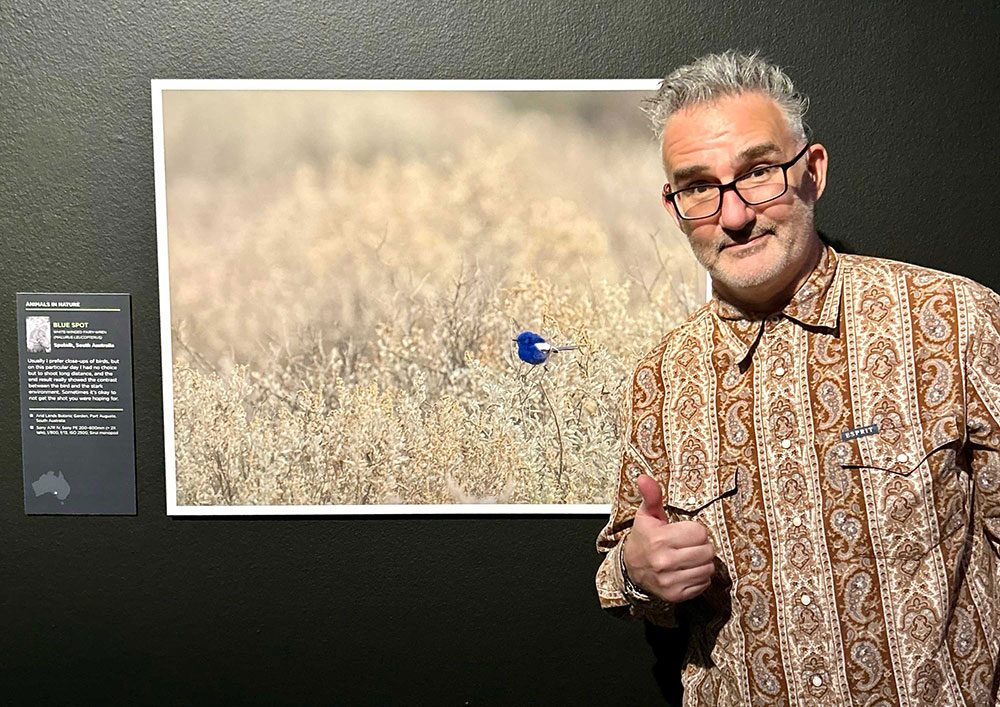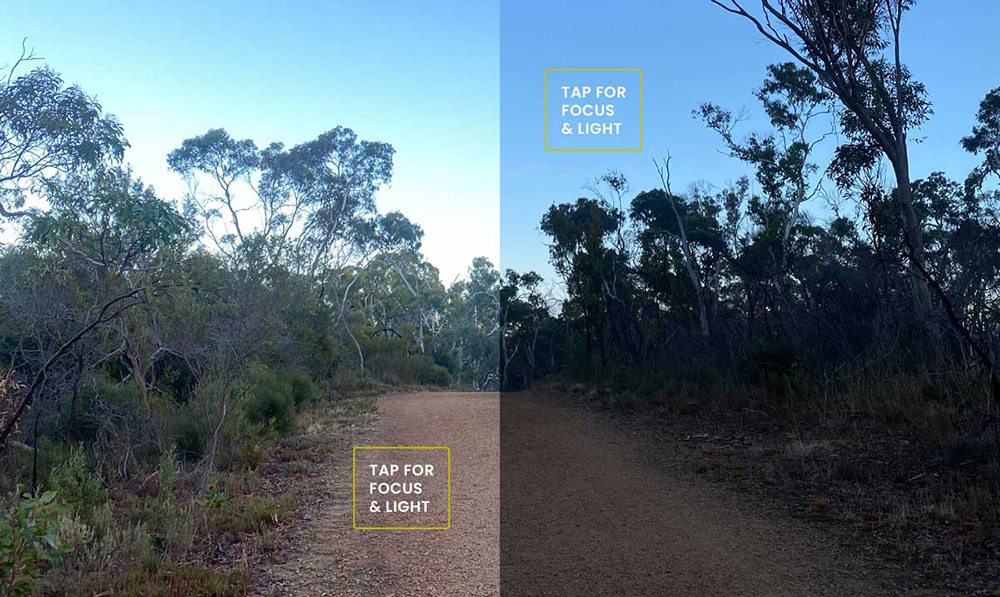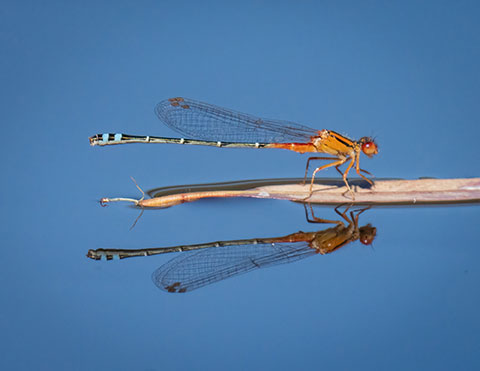By Sputnik
Sputnik is an Adelaide-based marketing and advertising professional, keen runner, and nature photographer, who has generously donated some of their nature photos for use in Nature Foundation’s marketing. You can see more of their photographs and outdoors antics here.
There are definitely way better nature photographers out there than me, but I did manage to be a finalist in the 2023 Australian Geographic Nature Photographer of Year competition, so I guess I’m not completely terrible at it. Actually, that’s not entirely true. Sometimes I’m still completely terrible at it, and I absolutely take waaaaay more bad photos than I do good ones. And although that’s not technically my first tip, accepting that you’ll take plenty of crappy shots on your way to a good one, is not a bad place to start. Even now it’s not unusual for me to take a few thousand shots in a day to end up with a handful of keepers. (On my most recent trip to Cambodia predominantly photographing wildlife, I took 31,126 shots in a couple of weeks!)

Here are my best nature photography tips:
1. Equipment.
Don’t worry about what camera/lens you do (or don’t) have, and what it can’t do. It’s easy to get in a tizz about not having a long lens for great shots of things that are far away, or not having a macro lens for tiny things that are close up. Almost every person who takes photos gets a case of the ‘what ifs’ - so just focus (literally and figuratively) on making the most of what you’ve got - even if it’s a smartphone which, honestly, has more technology in it than most cameras did not so long ago! (Sidenote: One of last year’s Nature Photographer of the Year category winners won with a pic taken on their iPhone!!!)
2. Adapt and improvise.
.jpg) Quite often I’ll go out with the goal of shooting something specific (like birds or even a certain species) and end up shooting something completely different. This is the secret to a good day as well as a good photo. Keep your eyes open to all kinds of natural beauty not just what you were hoping to photograph. Maybe you don’t get a pic of that bird that didn’t sit still long enough for you to fire off a few shots, but rain drops on a leaf don’t move anywhere near as fast and can be just as beautiful. Take that shot instead. (I shoot a lot of bugs and flowers when the birds are being uncooperative!)
Quite often I’ll go out with the goal of shooting something specific (like birds or even a certain species) and end up shooting something completely different. This is the secret to a good day as well as a good photo. Keep your eyes open to all kinds of natural beauty not just what you were hoping to photograph. Maybe you don’t get a pic of that bird that didn’t sit still long enough for you to fire off a few shots, but rain drops on a leaf don’t move anywhere near as fast and can be just as beautiful. Take that shot instead. (I shoot a lot of bugs and flowers when the birds are being uncooperative!)
3. ‘Pursuit of the craft’.
Some things you can learn from books and YouTube videos and articles (that are better than this), but there’s no substitute for what we call ‘pursuit of the craft’. AKA ‘just doing it’. Just take lots of photos. The more you take, the better you get. (There’s one proviso to that: you must spend at least a bit of time thinking about what you did and didn’t like, did and didn’t get right, in the pics you took.)
4. Practise.
.jpg) A bit like the previous point, I’d say practise might not make perfect, but it usually makes you at least a little bit less bad. Don’t wait for the time you see that rare, one-of-a-kind thing out in nature to decide you’re going to take the perfect photo. Practise on everyday things. This time of year, I have rainbow lorikeets and honeyeaters land in the flowering gum in my front yard, and I stand on my porch like an idiot, taking photos most mornings, just trying different things. I’ll also get the macro out and shoot the bees or the flowers themselves. Take photos of seagulls or dogs or weeds or flies… it doesn’t matter. Just because they’re common doesn’t mean you can’t still take a nice photo of them, and the practise will come in handy. If you’re not shooting on film and paying to have your pics developed, don’t be shy, really go for it and take as many as you want!
A bit like the previous point, I’d say practise might not make perfect, but it usually makes you at least a little bit less bad. Don’t wait for the time you see that rare, one-of-a-kind thing out in nature to decide you’re going to take the perfect photo. Practise on everyday things. This time of year, I have rainbow lorikeets and honeyeaters land in the flowering gum in my front yard, and I stand on my porch like an idiot, taking photos most mornings, just trying different things. I’ll also get the macro out and shoot the bees or the flowers themselves. Take photos of seagulls or dogs or weeds or flies… it doesn’t matter. Just because they’re common doesn’t mean you can’t still take a nice photo of them, and the practise will come in handy. If you’re not shooting on film and paying to have your pics developed, don’t be shy, really go for it and take as many as you want!
5. Nature photography groups.
If you’re on social media, consider joining a nature photography Facebook group e.g. Bird Photography Australia, and see what other people are doing. It’s a great place to get inspiration and to learn a bit about how people do what they do. And, where to find certain things to photograph! Which brings me to my next point…
6. Learn how your camera works.
It doesn’t hurt to try and learn a bit about how your camera works. Even if your camera is a smart phone. Most smart phones have manual overrides for some settings. You don’t need to completely nerd out and learn every single button or setting but switching from auto and just understanding and using a few basic things like turning the flash on or off, or learning a bit about focus or shutter speed can make a big difference. And honestly, there’s heaps of good videos on YouTube so you don’t even have to pay to learn. What a great time to be alive.

7. Best times for nature photography.
.jpg) Depending on what you’re shooting, you might find there are certain times of the day, or even certain times of the year, that are best. Interested in astro? The milky way is only visible in Australia from about February to October. Want to shoot Rainbow Bee Eaters in South Australia? They’re only here from about November to March. Native Orchids? July to October is prime time. Same concept goes with time of day. During summer, most birds and wildlife are more active first and last thing in the day - you might see something in the heat at 11am after you’ve had a sleep in, but you’ll have way more luck getting up early and trying your luck at 7am before it gets too hot. (It usually means there’s less people around too which can also be helpful. And nice.)
Depending on what you’re shooting, you might find there are certain times of the day, or even certain times of the year, that are best. Interested in astro? The milky way is only visible in Australia from about February to October. Want to shoot Rainbow Bee Eaters in South Australia? They’re only here from about November to March. Native Orchids? July to October is prime time. Same concept goes with time of day. During summer, most birds and wildlife are more active first and last thing in the day - you might see something in the heat at 11am after you’ve had a sleep in, but you’ll have way more luck getting up early and trying your luck at 7am before it gets too hot. (It usually means there’s less people around too which can also be helpful. And nice.)
8. Patience.
.jpg) The more you pay attention, the more you’ll notice, and the more you’ll learn about what’s what. You’ll learn which animals are shy and which ones are friendly. Where you’re more likely to see them.
The more you pay attention, the more you’ll notice, and the more you’ll learn about what’s what. You’ll learn which animals are shy and which ones are friendly. Where you’re more likely to see them.
If you’re a bit like me, you might even start wearing camouflage to blend in more or sitting or standing still for longer periods of time, to have a better chance of getting the pics you want.
(Don’t worry, I said I’d never do it either, and yet here I am, dressed as a shrub spending hours at a time waiting for an unsuspecting bird to visit.)
9. Move.
I could bore you to death with next-level tips like, trying to be aware of where you’re standing compared to your subject - what’s in the background, which way the light is going… there’s all sorts of things you can do to make your pic just a little bit nicer. Nature can be unpredictable so you don’t always get a say, but sometimes just taking a step to the left or right, or bending down and shooting a bit lower, will give you a slightly different perspective or view and make your photo way better.
10. Assessing your work.
 And finally, and this one is really important: there’s no such thing as a ‘right’ or ‘wrong’ photo. Or even a ‘good’ or a ‘bad’ one. There are just photos you do and don’t like. Even that blurry photo can be art if you want it to be. Sure, there’s competitions and judges who will say “this is a good photo”, but actually, it all comes down to personal preference. So, it’s all about taking photos you’re happy with even if other people aren’t offering to buy a copy for a million dollars. If a photo you’ve taken makes you happy, it’s a good photo. Maybe it’s basic, maybe it’s arty, it doesn’t matter. Maybe it’s over or under exposed or not perfectly in focus. If it reminds you of the time you saw that thing, helps you reconnect with nature, is something you can share with friends who aren’t photographic competition judges and who can see the beauty in what you saw, then you’ve taken a good photo. Plain and simple.
And finally, and this one is really important: there’s no such thing as a ‘right’ or ‘wrong’ photo. Or even a ‘good’ or a ‘bad’ one. There are just photos you do and don’t like. Even that blurry photo can be art if you want it to be. Sure, there’s competitions and judges who will say “this is a good photo”, but actually, it all comes down to personal preference. So, it’s all about taking photos you’re happy with even if other people aren’t offering to buy a copy for a million dollars. If a photo you’ve taken makes you happy, it’s a good photo. Maybe it’s basic, maybe it’s arty, it doesn’t matter. Maybe it’s over or under exposed or not perfectly in focus. If it reminds you of the time you saw that thing, helps you reconnect with nature, is something you can share with friends who aren’t photographic competition judges and who can see the beauty in what you saw, then you’ve taken a good photo. Plain and simple.
If all else fails, and you don’t get any decent pics, just remember to enjoy yourself while you’re out there. I know sometimes I’m guilty of feeling a bit disappointed if I don’t feel like I’ve taken any good photos, so I always do my absolute best to take a moment and breathe, take in the beauty of where I am, and remember to be grateful that I get to do that. Grateful that we’ve got some fantastic natural spaces. And, of course, remember how important it is that we protect them.
FOOTNOTE: I didn’t even touch on ‘post processing’ and how you can make your pics look better after you’ve taken them. That’s a topic for another day!
© All images copyright Sputnik, 2024.